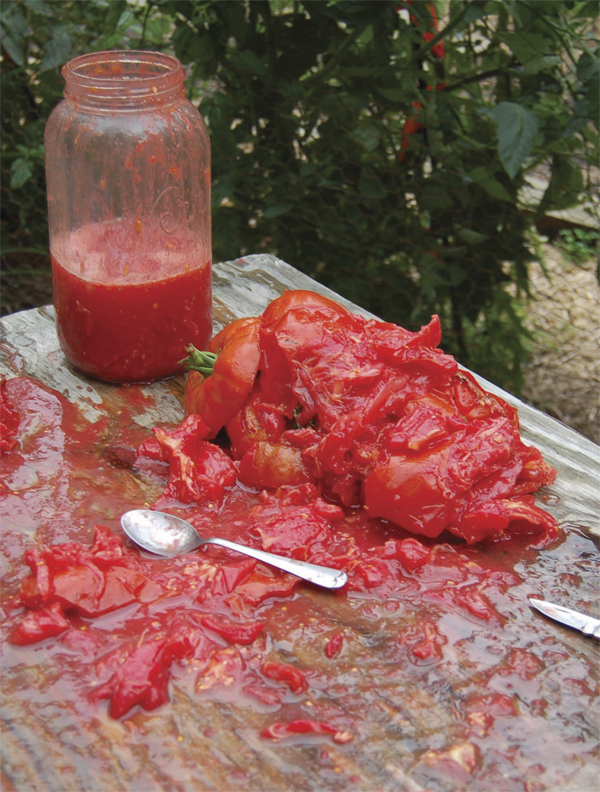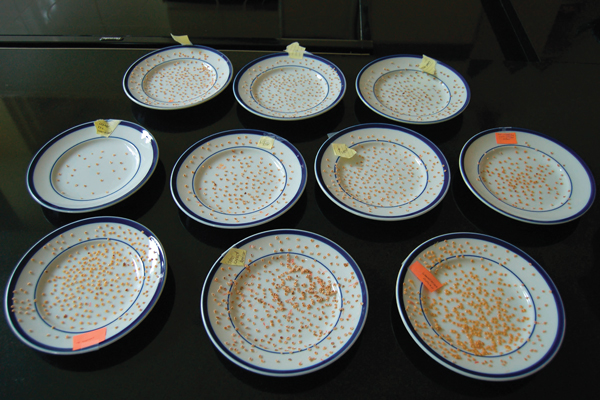
Chapter 22
Saving Your Seeds
Saving seeds from your open pollinated tomatoes is enjoyable and not at all difficult. There are many seed-saving techniques used by different growers. They all work. Below is but one of them.
Seed collection begins with covering the blossoms of those tomatoes that are to be used for seed harvesting to prevent cross pollination. This is necessary in order to be certain that you have pure seed. Covering the blossom becomes even more important if the variety of tomato from which you are saving seed has styles that protrude beyond the anther cone. Those tomato varieties with exerted stigmas are exposed to external pollen and have a greater likelihood of cross pollination. Most large fruited varieties, and particularly beefsteak tomatoes, have that tendency. Most tomatoes have a natural cross pollination rate of 2 to 5%.
The easiest way to prevent cross pollination is by bagging your blossoms before they open. One method used is to cover blossoms by placing them inside a bag made of bridal veil fabric. These can be purchased as small bridal favor bags. The bags must be removed after the tomatoes have self-pollinated, so that the tomato can grow to full size without restriction. After you remove the covering from the blossom, mark the tomato by tying a piece of string around the stem so that you can later identify it. Or you could just trim off the green sepals.

When collecting seeds, start with a ripe tomato. Find yourself a small clear plastic container with a lid of some sort. You can cover the container with clear wrap or tin foil. Slice the tomato in half and remove the pulp portion of the tomato that contains the seeds with a spoon, and by squeezing the tomato. Put the seeds and juice into the container. Try to fill it at least half-full. You may add a few tablespoons of water if the pulpy mixture is dry. Usually this is not necessary. Put the lid on the container and label it.
The container does not have to be air tight. The bacteria present on the tomato will begin to multiply and within a few hours start to break down the gelatinous material surrounding the seeds. In several days you will see small bubbles forming in the fluid in the container. This indicates that fermentation is under way. Allow the seeds to ferment for up to 3 days at 72˚, less time if it is warmer and more if it is cooler. After a few days, some white scum may begin to form on the top of the liquid in the container. If you take the seeds out too soon, they will still have some gelatinous material on them. If you wait too long, the seeds will appear dark but will still germinate. Some of them may begin to germinate right in the fermentation solution. It is better to take them out too soon than too late.

To remove the seeds from the container, take the covering off and add some water. Stir the contents up a bit with a spoon. The good seeds will fall to the bottom and the bad seeds will float. Pour off the top portion of the fluid making certain that the seeds on the bottom remain in the container. Repeat this several times until the seeds are clean and lying in the bottom of clear water. Pour the water and seeds into a strainer which has holes small enough so the seeds won't pass through. Wash them carefully and then place the seeds on a dish so they can dry. Spread the seeds so they are not touching one another. Label the dish. Once or twice a day, stir the seeds to make certain they come in contact with the air. After a week, the seeds will be dry enough to store in a paper envelope. Label the envelope and place the seeds inside. Store the envelope in a dry place such as a drawer. The seeds will be waiting for you when the next growing season arrives. Seeds stored for ten years or more will still germinate. However, the germination rate decreases as the years pass.

A simpler way to clean your seeds involves the use of OxiClean, a bleaching agent. Simply take the seeds you have removed from your tomato along with any juices and place them in a bowl or a jar. Add one tablespoon of OxiClean, which is a powder, to the container along with one to two cups of water. Stir. Let sit for one hour. Empty the container's contents onto a sieve and rinse the seeds. Put the seeds on a plate to dry. The rest is as above.